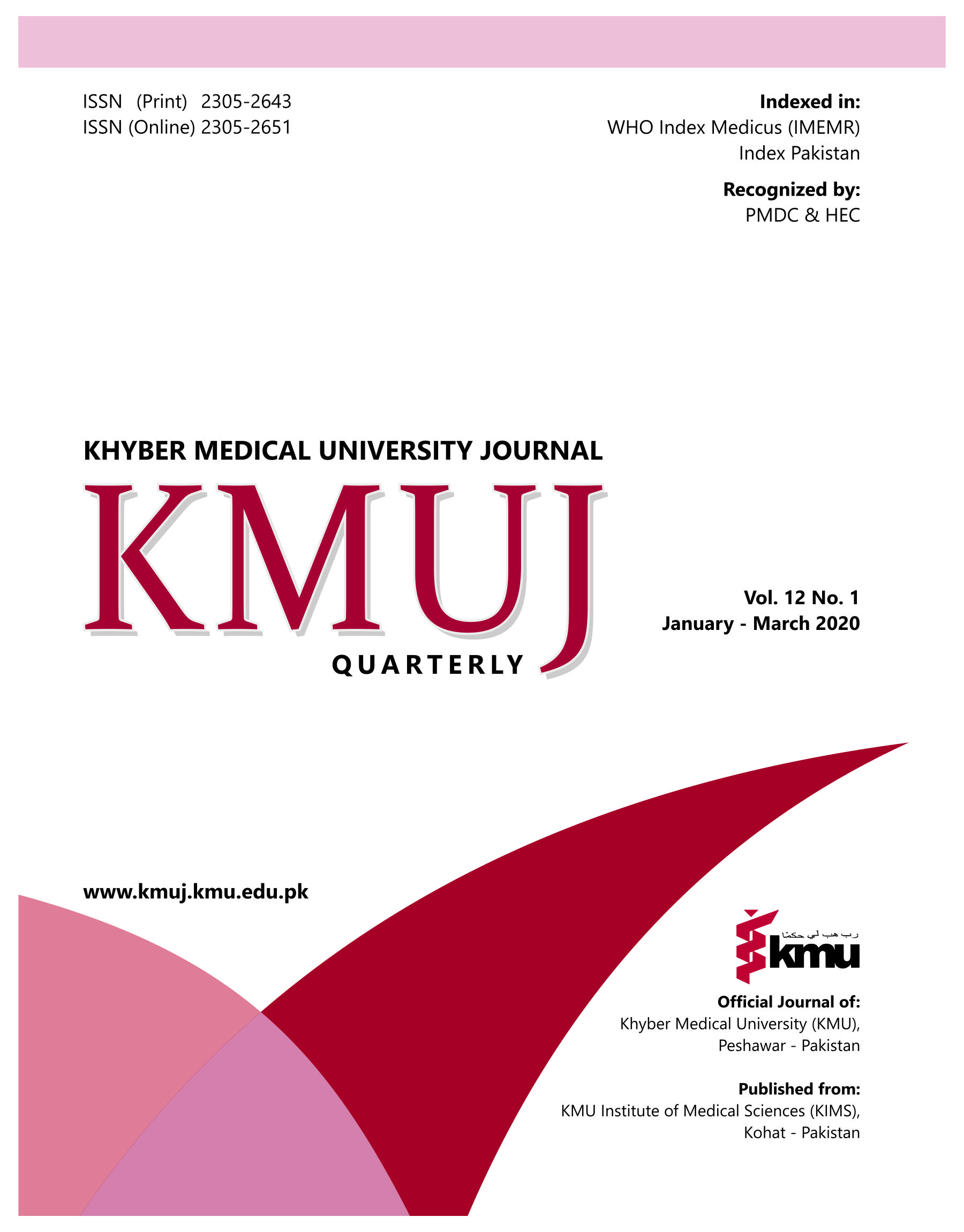POTENTIAL RISK FACTORS OF STROKE: A COMMUNITY-BASED, CROSS-SECTIONAL STUDY FROM SINDH PROVINCE OF PAKISTAN
Main Article Content
Abstract
OBJECTIVE: To determine the frequency of potential risk factors of stroke among peopleattending the stroke (Falij) screening camps in Sindh provinceof Pakistan.
METHODS: This descriptive cross-sectional study was conducted in the 12 rural and urban areas of Sindh through stroke screening camps, during the period of six months in 2018. A total of 1,480 consecutive persons18 years or above who had no prior stroke were enrolled.The questionnaire comprised of demographic information, stroke related risk factors, personal history, family history of stroke and investigations did during the camp. Stroke-related risk was categorized as low-risk (1-2 risk factors), moderate-risk (3 risk factors) and high-risk (≥4 risk factors). Out of 1,480 persons screened, twenty-eight persons were excluded due to missing information and final sample size was 1,452. Statistical analysis was performed on SPSS version-21.
RESULTS: Out of 1,452 subjects, 802 (55.2%) were males and 650 (44.8%) were females. Mean age was 46.7±13.8 years and majority (n=1026; 70.6%) were aging >40 years.Mean BMI was 29.2±14.4. Low-, moderate- and high-risk groups included 691 (47.6%), 614 (42.3%) & 147 (10.1%) cases respectively. Common potential risk factors of stroke were hypertension (n=722; 49.8%), diabetes mellitus (n=518; 35.7%), dyslipidemia (n=290; 19.97%) and smoking (n=288; 19.8%).
CONCLUSION: Common potential risk factors of stroke in our study are hypertension, diabetes, dyslipidemia and smoking. More than half of the participants have potentially moderate- and high-risk of stroke. Robust population-based studies are needed to study the epidemiology of stroke and its risk factors in Pakistan.
Article Details
Work published in KMUJ is licensed under a
Creative Commons Attribution 4.0 License
Authors are permitted and encouraged to post their work online (e.g., in institutional repositories or on their website) prior to and during the submission process, as it can lead to productive exchanges, as well as earlier and greater citation of published work.
(e.g., in institutional repositories or on their website) prior to and during the submission process, as it can lead to productive exchanges, as well as earlier and greater citation of published work.
References
World Health Organization (WHO). Global Status Report on Noncommunicable Disease 2010 [Internet]. WHO Press; 2011[Accessed on: March 23, 2019]. Available from URL: http://apps.who.int/medicinedocs/en/m/abstract/Js18629en/
Alwan A, Maclean DR, Riley LM, d'Espaignet ET, Mathers CD, Stevens GA, et al. Monitoring and surveillance of chronic non-communicable diseases: progress and capacity in high-burden countries. Lancet 2010;376(9755):1861-8. DOI: 10.1016/S0140-6736(10)61853-3.
Murray CJ, Barber RM, Foreman KJ, Abbasoglu-Ozgoren A, Abd-Allah F, Abera SF, et al. Global, regional, and national disability-adjusted life years (DALYs) for 306 diseases and injuries and healthy life expectancy (HALE) for 188 countries, 1990-2013: Quantifying the epidemiological transition. Lancet 2015;386(10009):2145–91.DOI: 10.1016/S0140-6736(15)61340-X.
Naghavi M, Wang H, Lozano R, Davis A, Liang X, Zhou M, et al. Global, regional, and national age-sex specific all-cause and causespacific mortality for 240 causes of death, 1990-2013: a systematic analysis for the Global Burden of Disease Study 2013. Lancet 2015;385(9963):117–71.DOI: 10.1016/S0140-6736(14)61682-2
Krishnamurthi RV, Moran AE, Forouzanfar MH, Bennett DA, Mensah GA, Lawes CM, et al. The global burden of hemorrhagic stroke: a summary of findings from the GBD 2010 study. Glob Heart 2014;9(1):101-6. DOI:10.1016/j.gheart.2014.01.003.
Bang OY, B. Ovbiagele J, Kim S. Nontraditional risk factors for ischemic stroke: An update. Stroke 2015;46(12): 3571–78. doi: 10.1161/STROKEAHA.115.010954.
Hopewell JC, Clarke R. Emerging risk factorsfor stroke: what have we learned from Mendelian Randomization Studies? Stroke 2016;47(6):1673-8. DOI: 10.1161/STROKEAHA.115.010646.
Von Sarnowski B, Putaala J, Grittner U, Gaertner B, Schminke U, Curtze S, et al., Lifestyle risk factors for ischemic stroke and transient ischemic attack in young adults in the stroke in young fabry patients study. Stroke 2013;44(1):119-25. DOI: 10.1161/STROKEAHA.112.665190.
FeiginVL, Roth GA, Naghavi M, Parmar P, Krishnamurthi R, Chugh S, et al. Global burden of stroke and risk factors in 188 countries, during 1990-2013: a systematic analysis for the Global Burden of Disease Study 2013. Lancet Neurol. 2016;15(9):913-24. DOI: 10.1016/S1474-4422(16)30073-4.
Khan MI, Khan JI, Ahmed SI, Haq U. The epidemiology of stroke in a developing country (Pakistan). J Neurol Stroke 2018;8(1):32-40. DOI: 10.15406/jnsk.2018.08.00275
Feigin VL. Stroke epidemiology in the developing world.Lancet 2005;365(9478):2160-1.DOI: 10.1016/S0140-6736(05)66755-4
Zuhaid M, Salman, Chawla JA, Farooq U, Ahmad A, Khan S, et al. Frequency of modifiable risk factors in stroke patients. J Ayub Med Coll Abbottabad 2014;26(2):235–8.
Lahano AK, Chandio MA, Bhatti MI. Frequency of common risk factors for stroke.Gomal J Med Sci 2014; 12: 222-6.
HabMIbi-koolaee, Shahmoradi L , Sharareh R,Kalhori N, et al. Prevalence of Stroke Risk Factors and Their Distribution Based on Stroke Subtypes in Gorgan: A Retrospective Hospital-Based Study—2015-2016. Neurol Res Int 2018;2018: 2709654. DOI: 10.1155/2018/2709654.
Malik A, Malik F, Khatri I, Nasir S. Risk Factors for Stroke and TIA's in Pakistan: A Community-Based Study. Pak J Neurological Sci 2018; 13(1):17-22.
Zhang FL, Guo ZN, Wu YH, Liu HY, Luo Y, Sun MS, et al. Prevalence of stroke and associated risk factors: a population based cross sectional study from northeast China. BMJ Open 2017;7(9):e015758. DOI: 10.1136/bmjopen-2016-015758.
Setyopranoto I, BayuanggaHF, Panggabean AS, Alifaningdyah S, Lazuardi L et al. Prevalence of Stroke and Associated Risk Factors in Sleman District of Yogyakarta Special Region, Indonesia. Stroke Res Treat 2019;2019:2642458. DOI:10.1155/2019/2642458.
Boehme AK, Esenwa C, Elkind MS. Stroke Risk Factors, Genetics, and Prevention. Circ Res. 2017;120(3):472-95. DOI: 10.1161/CIRCRESAHA.116.308398.
Haroon Jamal. Quantifying Sub-National Human Development Indices from Household Survey Data. Social Policy and Development Centre: Karachi; 2016. Report No.: 96. [Accessed on: Mar 23, 2019]. Available from URL: https://www.spdc.org.pk/publications/quantifying-sub-national-human-development-indices-from-household-survey-data.
